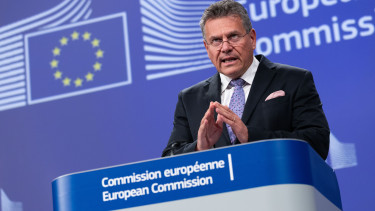The European economy is trapped, facing two threats at once

You will get answers to the following questions from this article:
- Why is the European economy trapped?
- What is wrong with wage increases in Europe?
- What is the analysts' inflation outlook?
- Could growth recovery in Europe?
- What is the economic outlook on the continent?
Europe's economy is in a difficult situation: while growth is depressed, inflation remains high and the outlook is very difficult to interpret. In the euro area, there has been no meaningful growth for two years now. The economy expanded by 0.3% in both the first and second quarters of this year, after stagnating before that, and there are no signs of a rebound yet.

The stagnation of previous years has been caused by falling consumption due to high inflation, soaring energy prices and a sharp fall in industry due to high interest rates. Industry is still struggling, but the services sector is starting to recover. We are seeing a particular divergence as a result: while manufacturing is deteriorating, the services sector has started to recover. This is true in most countries, and in France, for example, it is particularly striking.

Meanwhile, wage growth has been diminishing sluggishly, but the rate remains well above the level that would be consistent with the European Central Bank's 2% inflation target. In Europe, too, it is a special situation that, although real wages are growing at a rate not seen for a long time, consumption does not want to pick up. However, inflation remained elevated at 2.6% in July.

The outlook is extremely cloudy,
as weak demand should be dampening inflation, but this is only partially evident at the moment. High wage dynamics should, in turn, stimulate consumption, but it is apparently happening only sporadically. The rebound in consumption is most notable in Germany and, if we look outside the euro area, Hungary is in the same boat. A pick-up in consumption would improve growth prospects, but would increase inflation risks. This is the difficult environment in which the European Central Bank has to operate.
Very delicate balance to be maintained in the European economy
"We know that the ECB is monitoring closely the wages-margins-productivity triangle, expecting slower wages growth, a compression of profit margins, and a recovery in productivity gains," Hélène Baudchon, economist at BNP Paribas, told Portfolio in an e-mailed response to our questions.
"Regarding the former, signs of wage moderation remain mixed so far but on balance, the direction is one of moderation. The compression of profit margins remains to be confirmed too, but such a compression is more likely than not," she added.
For now, the recovery in productivity gains is the most uncertain part of the triangle,
noted Baudchon.
In this respect, she highlighted that the moderation in wages is a necessary condition to continue to fuel the disinflation process but this wage moderation must not be too rapid either because the support from real wages gains is one of the key factors in strengthening the recovery in the euro area.
And this recovery is key to support the expected cyclical rebound in productivity, while this latter is itself crucial in returning inflation to the 2% target. All is intertwined,
she said.
"At the end of the day, this explains why core disinflation remains a slow process, why we still see some stickiness in services inflation in particular, and expect limited further improvement of core inflation by year-end, before more significant progress in 2025, with inflation broadly around the 2% target by the end of next year."
"Wage growth is still robust, but we share the ECB’s view that recent figures were distorted [retroactively - editor's note] by multiyear agreements, so still catching up with previous inflation," Rainer Singer, economist at Austria's Erste Bank, wrote Portfolio in an e-mailed response.
"ECB economists have as basis for their forecasts only a significant slowing down of wage growth next year. So the data up to now is consistent with ECB’S forecast of inflation reaching the target in the second half of 2025, which is crucial," he added.
Erste Bank projects inflation to drop to 2.1% by end-2025 from 2.4% at the end of this year.
| European Central Bank GDP and inflation forecasts | |||
| GDP growth | |||
| Date of estimate | 2024 | 2025 | 2026 |
| June 2024 | 0.9% | 1.4% | 1.6% |
| March 2024 | 0.6% | 1.5% | 1.6% |
| December 2024 | 0.8% | 1.5% | 1.5% |
| CPI | |||
| Date of estimate | 2024 | 2025 | 2026 |
| June 2024 | 2.5% | 2.2% | 2.0% |
| March 2024 | 2.3% | 2.0% | 1.9% |
| December 2024 | 2.7% | 2.1% | 1.9% |
| Sources: ECB, Portfolio | |||
What could be the ECB's move?
The central bank implemented a historic tightening of 450 basis points between summer 2022 and autumn 2023, and started cutting interest rates in June 2024. The ECB is treading on very thin ice when it comes to setting monetary policy, because if it does not cut interest rates sufficiently, the recovery in demand will not take place and growth will not return to the continent for some time. However, with historically very high wage growth, the ECB still fears that inflation will remain elevated.

"An economy that seems to be growing slower than expected gives additional support for the attainment of the inflation goal next year. So, we feel confident with our forecast of three rate cuts (25bp each) until the end of the year and three rate cuts in 2025," Singer said. Erste Bank expects the euro area to grow by 0.7% this year and by 1.1% next year.
Economists at BNP Paribas currently expect Eurozone real GDP growth to reach 0.8% in 2024 in annual average terms before a more significant rebound in 2025, at 1.6%.
"So, following a rather positive first half, we do see the mild economic recovery to continue in the Eurozone, supported by the fading of the energy shock, real wages gains, a less restrictive monetary policy, and the NGEU funds," said Hélène Baudchon.
She warned, however, that "soft data have been moving sideways since the start of the year, especially the Economic Sentiment Index, the composite PMI being better oriented. However, this lack of upward momentum of the ESI combined with near-term political uncertainty, in France and in the US, struggling growth in China, still some lagged negative impact of the hiking cycle, and more significant fiscal consolidation next year, all of that constitutes downside risks to growth."
As regards euro area rates, she said that "a gradual cutting cycle appears the most likely scenario to date, in order to accompany the progressive fall in inflation and the progressive pick-up in activity."
Simply put, we expect five more rate cuts by the end of 2025, 25 bps each, one each quarter,
with a terminal deposit rate at 2.50% [...] and the two next cuts coming in September and December this year." This is the level they consider broadly neutral, i.e. one that does not stimulate or stymie economic activity.
Euro area annual inflation is expected to be 2.2% in August 2024, down from 2.6% in July according to a flash estimate from Eurostat, the statistical office of the European Union. The German inflation data came in yesterday (after analysts' responses) and was lower than expected, supporting expectations that the ECB may implement significant interest rate cuts.
Looking at the main components of euro area inflation, services is expected to have the highest annual rate in August (4.2%, compared with 4.0% in July), followed by food, alcohol & tobacco (2.4%, compared with 2.3% in July), non-energy industrial goods (0.4%, compared with 0.7% in July) and energy (-3.0%, compared with 1.2% in July).
Cover image (for illustration purposes only): Getty Images









